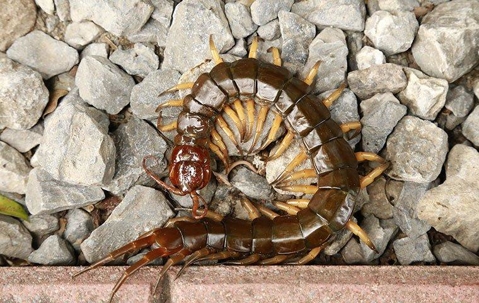Insects and arthropods are, as a whole, incredibly beneficial to the environment, but they're never fun to find in your Queen Creek home. Some are more dangerous to have around your property than others, but some are mere nuisances, like the house centipede. Centipedes really prefer staying outside and don't often infest homes, but like all occasional invaders, there are certain circumstances that entice them indoors.
Appearance And Information On House Centipedes
House centipedes are relatively small, growing up to 1 ½ inch long and only sporting 15 pairs of spindly legs. They have long, flat bodies that are light yellowish-brown in color, with roughly three dark stripes that run down the length of their backs. Rather than a venomous bite, centipedes have a front pair of legs that are filled with venom, which they use to immobilize prey and defend themselves against predators.
Though somewhat painful, a house centipede sting isn't dangerous for humans and is incredibly rare as they're more likely to flee than attack. Most people view these occasional invaders to be more helpful as well since their diet subsists of a myriad of pesky insects, including but not limited to:
- Cockroaches
- Silverfish
- Flies
- Small spiders
- Crickets
- Moths
- Earwigs
- Ants
- Termites
- Bed bugs
Why House Centipedes Find Themselves In Queen Creek Homes
Centipedes in general prefer living outside, sticking to their mulch and leaf piles, dense underbrush, and underneath rocks and logs. If the weather gets too hot though, or they discover a surplus of delicious pests in your Queen Creek home, they may be tempted to venture indoors. Both reasons pose significant concerns, as centipedes require high levels of moisture and adequate food sources in order to survive.
How To Keep House Centipedes Outside And Away From Your Queen Creek Home
Since these critters prefer staying outside anyway, prevention is really a matter of eliminating easy access and reducing attractive qualities your home may have or could possibly invite. These preventative measures include:
- Seal up any cracks and holes around the foundation, exterior siding, and outdoor-leading pipes and wires
- Replace worn-down insulation around doors and windows
- Check pipes for any leaks, inspect home for extensive water damage, and repair as necessary
- Invest in a dehumidifier for moisture retaining rooms; kitchen, bathroom, basement, laundry room
- Remove brush, leaf, and woodpiles from around the exterior of your home, and clear out any underbrush on your property
- Maintain general pest prevention; wipe down counters and food prep areas, proper food storage, clean floors regularly, reduce clutter, clean up food and drink spills immediately
Getting Rid Of House Centipedes In Your Queen Creek Home
While these pests aren't dangerous or destructive, they're still unsightly and disconcerting, and they could even be an indicator of an even worse pest problem in your Queen Creek home. There's no telling what else might be plaguing your property if they've made an appearance, and at-home pest exterminations are rarely as effective as many have claimed. Your best bet for getting rid of centipedes, and pests that attract them, is to call in the professionals instead.
At Pro Active Pest Control, we strive to provide effective, affordable, and friendly service, while staying mindful of our customer's health and the safety of the environment. We always use eco-friendly pest control products in all of our treatments, and we back every visit with our 100% satisfaction guarantee. If you're still noticing pest problems after we've treated your property, we keep coming back until they're gone, at no additional cost. So get in contact with us today, and breathe easy knowing your home and family are fully protected.

